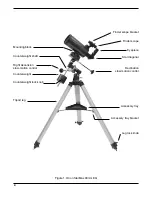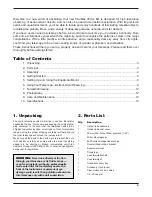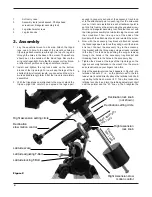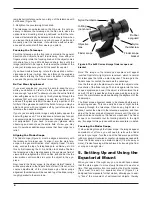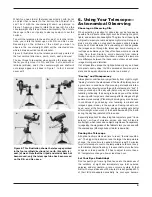
7
keeping them from drifting out of the telescope’s field of view
while you’re observing.
This is accomplished by slowly rotating the telescope on its
right ascension (R.A.) axis, using only the R.A. slow-motion
cable. But first the R.A. axis of the mount must be aligned with
the Earth’s rotational (polar) axis - a process called polar
alignment.
Polar Alignment
For Northern Hemisphere observers, approximate polar
alignment is achieved by pointing the mount’s R.A. axis at the
North Star, or Polaris. It lies within 1° of the north celestial
pole (NCP), which is an extension of the Earth’s rotational
axis out into space. Stars in the Northern Hemisphere appear
to revolve around the NCP.
To find Polaris in the sky, look north and locate the pattern of
the Big Dipper (Figure 5). The two stars at the end of the
“bowl" of the Big Dipper point right to Polaris.
Observers in the Southern Hemisphere aren’t so fortunate to
have a bright star so near the south celestial pole (SCP). The
star Sigma Octantis lies about 1° from the SCP, but it is bare-
ly visible with the naked eye (magnitude 5.5).
For general visual observation, an approximate polar align-
ment is sufficient.
1.
Level the equatorial mount by adjusting the length of the
three tripod legs.
2.
Loosen the latitude lock t-bolt. Turn the latitude adjust-
ment t-bolt and tilt the mount until the pointer on the
latitude scale is set at the latitude of your observing site.
If you don’t know your latitude, consult a geographical
atlas to find it. For example, if your latitude is 35° North,
set the pointer to 35. Then retighten the latitude lock t-
bolt. The latitude setting should not have to be adjusted
again unless you move to a different viewing location
some distance away.
3.
Loosen the Dec. lock knob and rotate the telescope opti-
cal tube until it is parallel with the R.A. axis, as it is in
Figure 1. The pointer on the Dec. setting circle should
read 90°. Retighten the Dec. lock lever.
4.
Loosen the azimuth lock knob at the base of the equatori-
al mount and rotate the mount so the telescope tube (and
R.A. axis) points roughly at Polaris. If you cannot see
Polaris directly from your observing site, consult a com-
pass and rotate the mount so the telescope points North.
Retighten the azimuth lock knob.
The equatorial mount is now polar aligned for casual observ-
ing. More precise polar alignment is recommended for
astrophotography.
From this point on in your observing session, you should not
make any further adjustments in the azimuth or the latitude of
the mount, nor should you move the tripod. Doing so will undo
the polar alignment. The telescope should be moved only
about its R.A. and Dec. axes.
Use of the R.A. and Dec. Slow-Motion Control
Cables
The R.A. and Dec. slow-motion control cables allow fine
adjustment of the telescope’s position to center objects within
the field of view. Before you can use the cables, you must
manually “slew" the mount to point the telescope in the vicini-
ty of the desired target. Do this by loosening the R.A. and
Dec. lock knobs and moving the telescope about the mount’s
R.A. and Dec. axes. Once the telescope is pointed some-
where close to the object to be viewed, retighten the mount’s
R.A. and Dec. lock knobs.
The object should now be visible somewhere in the tele-
scope’s finder scope. If it isn’t, use the slow-motion controls to
scan the surrounding area of sky. When the object is visible in
the finder scope, use the slow-motion controls to center it.
Now, look in the telescope’s eyepiece. If the finder scope is
properly aligned, the object should be visible somewhere in
the field of view. Once the object is visible in the eyepiece, use
the slow-motion controls to center it in the field of view.
The Dec. slow-motion control cable can move the telescope a
maximum of 25°. This is because the Dec. slow-motion mech-
anism has a limited range of mechanical travel. (The R.A.
slow-motion mechanism has no limit to its amount of travel). If
you can no longer rotate the Dec. control cable in a desired
direction, you have reached the end of travel, and the slow-
motion mechanism must be reset. This is done by first rotating
the control cable several turns in the opposite direction from
which it was originally being turned. Then, manually slew the
telescope closer to the object you wish to observe (remember
to first loosen the Dec. lock knob). You should now be able to
use the Dec. slow-motion control cable again to fine adjust the
telescope’s position.
Tracking Celestial Objects
When you observe a celestial object through the telescope,
you’ll see it drift slowly across the field of view. To keep it in
the field, if your equatorial mount is polar aligned, just turn the
R.A. slow-motion control cable clockwise. The Dec. slow-
Figure 5. To find Polaris in the night sky, look north and
find the Big Dipper. Extend an imaginary line from the
two "Pointer Stars" in the bowl of the Big Dipper. Go
about five times the distance between those stars and
you'll reach Polaris, which lies within 1° of the north
celestial pole (NCP).
Big Dipper
(in Ursa Major)
Little Dipper
(in Ursa Minor)
Cassiopeia
N.C.P.
Poin
ter
Star
s
Polaris


